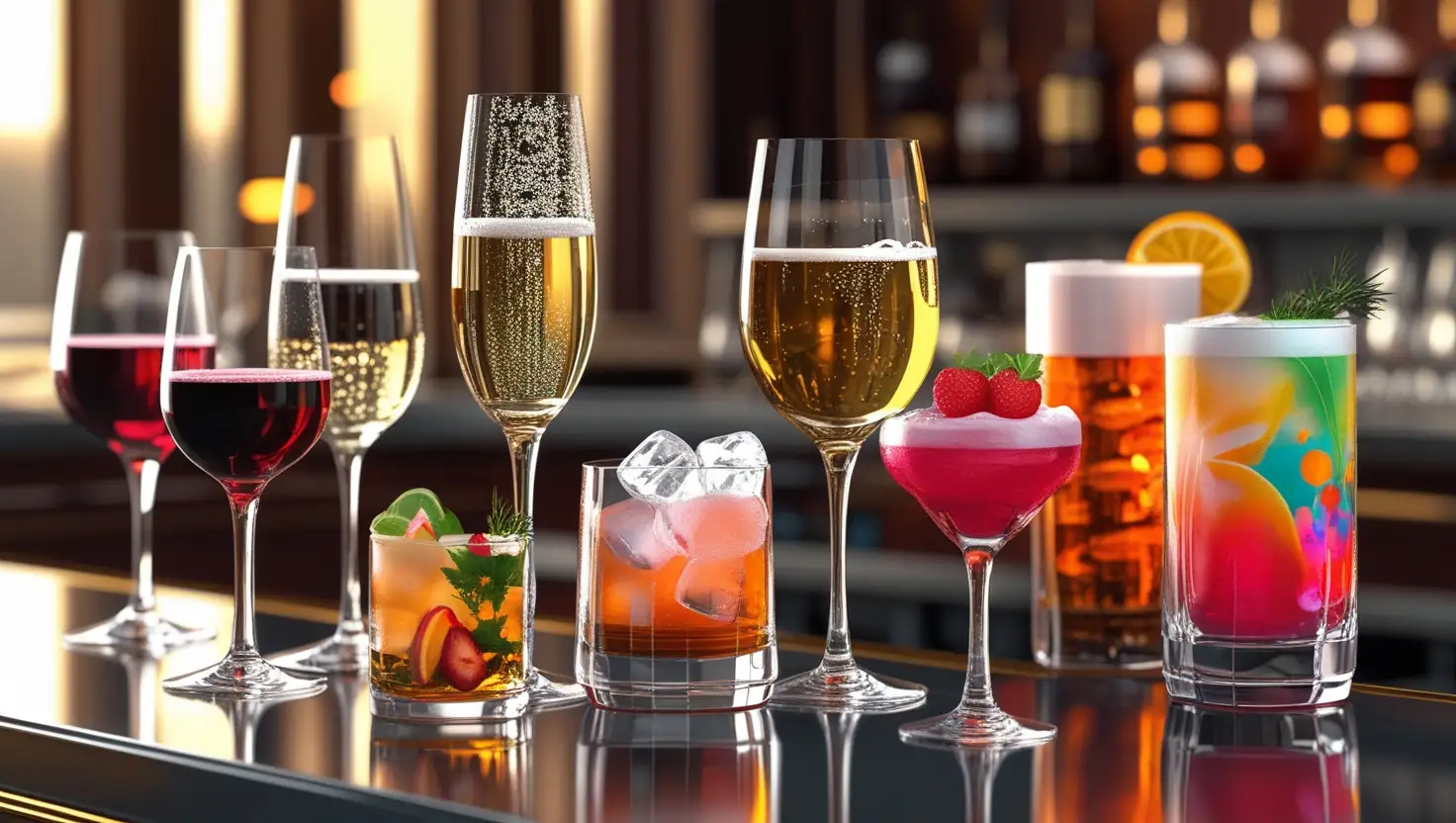Food and beverage service outlets use a variety of glasses for different types of drinks, which require a significant investment in delicate and fragile equipment. The style, quality, and sparkle of the glass selected portray the profile of the restaurant. Glassware plays a crucial role in enhancing the drinking experience by preserving the flavours, aromas, and presentation of beverages.
Although there are many glasses for different drinks, it is better to use limited types of glasses that may be suitable for various beverages.
This guide explores the classification, features, and common types of glassware used in the food and beverage industry.
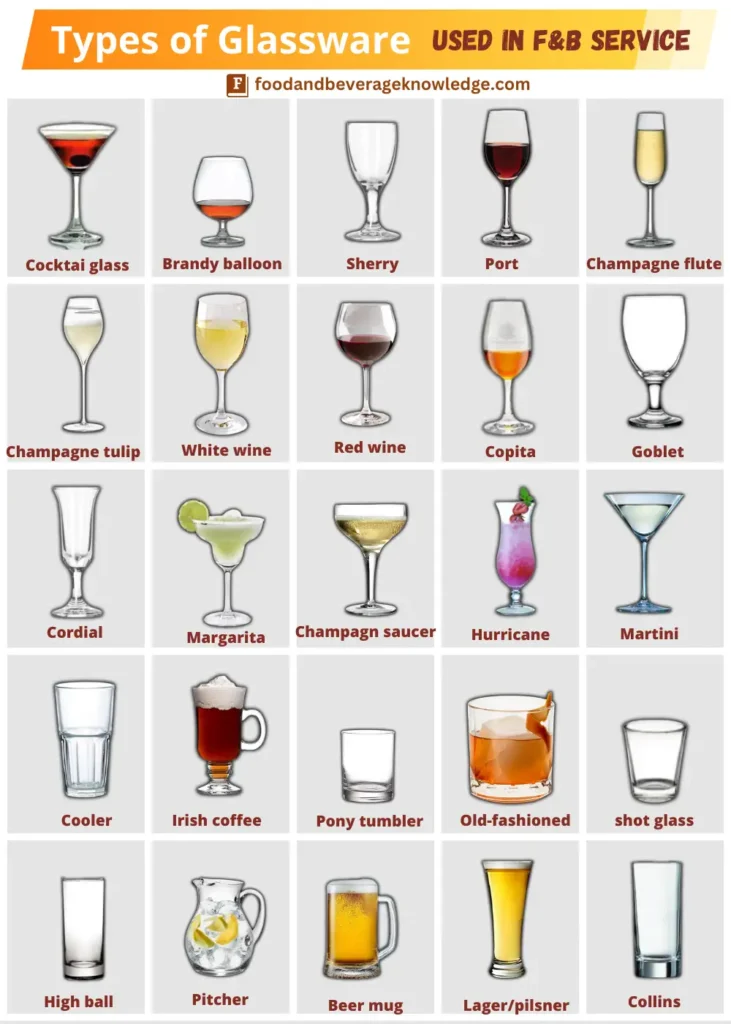
Importance of Selecting the Right Glassware
- Enhances Presentation: Proper glassware enhances the visual appeal of drinks, making them more enticing.
- Preserve Temperature: Different glasses are designed to maintain the ideal temperature of beverages.
- Enhances Aromas and Flavors: The shape of the glass affects how a drink’s aromas are perceived.
- Improves Guest Experience: Elegant and functional glassware contributes to the overall dining experience.
- Brand Identity: The quality and type of glassware reflect the restaurant’s image and positioning in the market.
Classification of Glassware Based on Structure and Design
Glassware is classified based on its design and Structure. The primary classifications include:
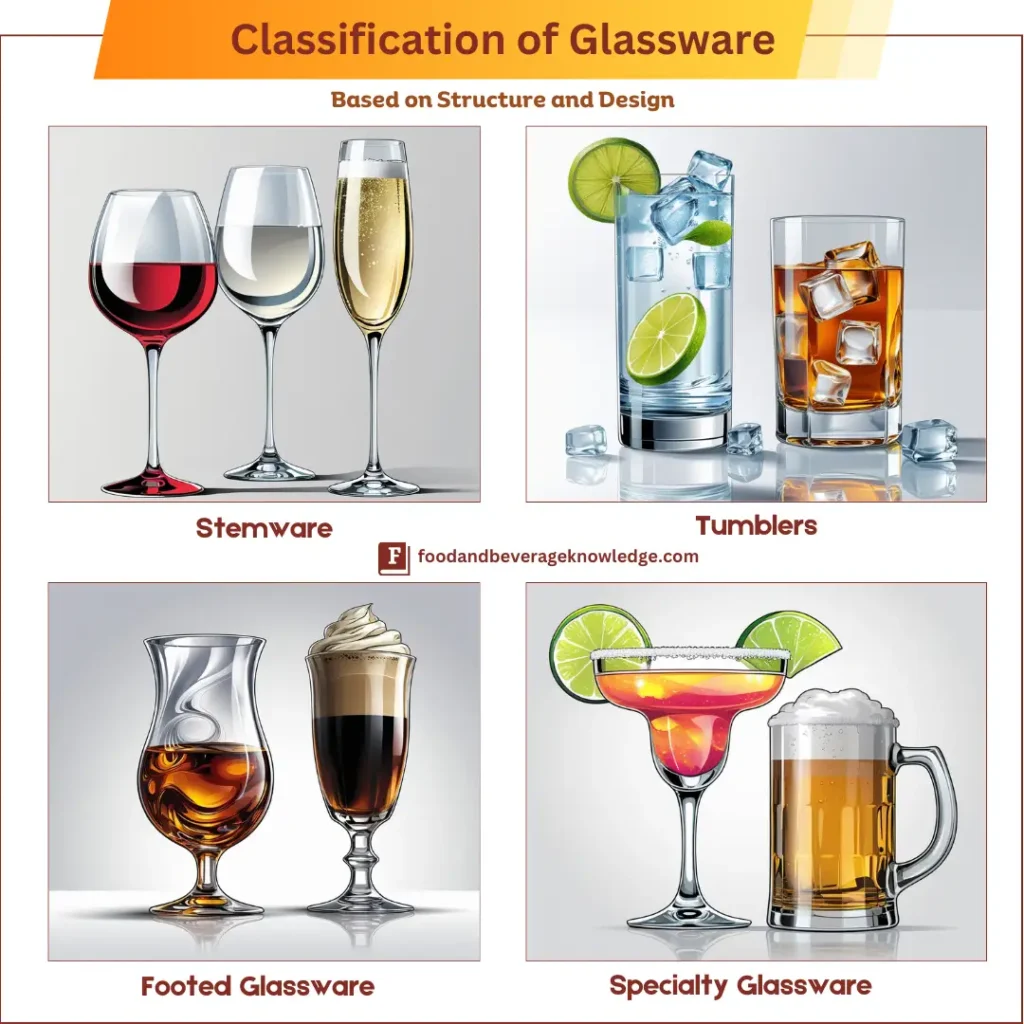
1. Stemware
Stemware refers to glasses that have a bowl supported by a long stem and a flat base. The stem allows users to hold the glass without touching the bowl, preventing body heat from warming the beverage.
This type of glassware is commonly used for serving wines, champagnes, and select cocktails. The shape and size of the bowl vary to enhance the aroma and flavour of different drinks.
✅ Examples:
- Red Wine Glass – Large, round bowl to allow aeration and enhance aromas.
- White Wine Glass – Smaller bowl to maintain a cooler temperature and concentrate delicate aromas.
- Champagne Flute – Tall, narrow design to preserve bubbles and carbonation.
- Martini Glass – Wide, conical bowl, ideal for serving martinis and cocktails.
- Cordial Glass – Small-stemmed glass designed for serving liqueurs and digestifs.
2. Tumblers
Tumblers are flat-bottomed glasses without stems, known for their sturdy and versatile design. They are commonly used for serving a variety of beverages, including spirits, cocktails, and non-alcoholic drinks.
The walls of tumblers can be straight, slightly curved, or tapered, depending on the drink they are designed for. They are ideal for everyday use due to their durability and ease of handling.
✅ Examples:
- Highball Glass – Tall, straight-sided glass used for mixed drinks like gin and tonic or whiskey soda.
- Old Fashioned Glass (Lowball/Rocks Glass) – Short, wide glass ideal for whiskey, scotch, and cocktails served over ice.
- Collins Glass – Similar to a highball but taller and narrower, commonly used for Tom Collins and mojitos.
- Juice Glass – Smaller tumbler used for serving fresh juices or water.
- Water Glass – Standard tumbler used for serving water in restaurants and households.
3. Footed Glassware
Footed glassware features a short stem and a wide, stable base that elevates the bowl above the surface. This design enhances both the presentation and functionality of the glass, making it suitable for specific beverages.
Footed glasses are commonly used for serving brandy, beer, speciality cocktails, and even desserts. Their structure helps in maintaining the correct temperature of the drink while providing an elegant touch.
✅ Examples include :
- Brandy Snifter – Wide bowl with a short stem, designed for swirling and enhancing brandy or cognac aromas.
- Absinthe Glass – Footed glass designed for the traditional preparation of absinthe.
- Irish Coffee Glass – Heat-resistant footed glass used for serving Irish coffee and hot alcoholic beverages.
- Coupette Glass – Footed glass with a wide, shallow bowl, often used for margaritas and daiquiris.
- Goblet – Large, footed glass used for serving beer, sangria, or speciality drinks.
4. Specialty Glassware
speciality glassware is designed to complement specific drinks by enhancing their presentation, aroma, and overall experience. These glasses often have unique shapes and sizes tailored to the characteristics of a particular beverage.
The design can influence factors such as carbonation retention, ice accommodation, and garnish placement. Specialty glassware plays a crucial role in cocktail making, beer service, and fine dining.
✅ Examples:
- Margarita Glass – Wide-rimmed glass designed for margaritas, allowing space for salt or sugar rims.
- Hurricane Glass – Tall, curvy glass used for tropical cocktails like piña coladas and hurricanes.
- Beer Mug – Thick-walled glass with a handle, ideal for serving draft beer while keeping it cold.
- Copper Mug – Traditionally used for Moscow Mules, helping maintain the drink’s chilled temperature.
- Shot Glass – Small, thick glass used for serving straight liquor shots like tequila, vodka, or whiskey.
Common Types of Glassware in Food & Beverage Service
Each glass is specifically designed to enhance the drinking experience of different beverages. Below is a list of the most common glassware used in restaurants, bars, and hotels.
Wine Glasses
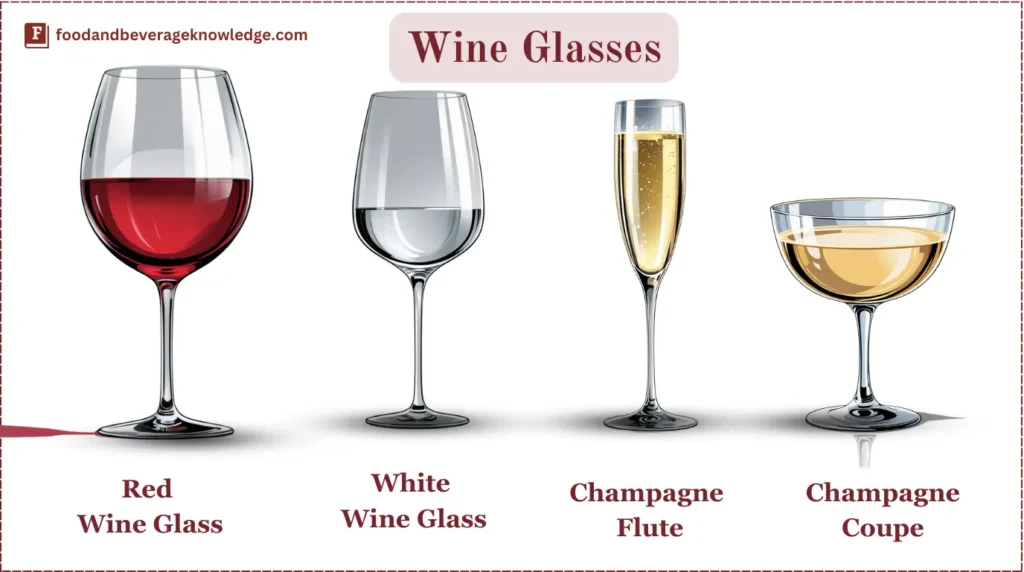
1. Red Wine Glass
Size: 12–16 oz
With a broad bowl, this glass allows red wines to “breathe,” enhancing their flavour. The larger surface area helps release complex aromas and flavours. Typically used for full-bodied red wines like Cabernet Sauvignon or Merlot.
2. White Wine Glass
Size: 8–12 oz
Smaller with a narrower bowl, this glass helps preserve the delicate aromas of white wines. Its design keeps the wine cool while concentrating the subtle aromas. Best suited for crisp white wines like Sauvignon Blanc or Chardonnay.
3. Champagne Flute
Size: 6–8 oz
Tall, narrow, and designed to preserve bubbles, the flute allows sparkling wine to retain its effervescence. This shape ensures the aromas are concentrated towards the nose. Ideal for serving champagne, prosecco, and other sparkling wines.
4. Champagne Coupe
Size: 6–8 oz
With a wide, shallow bowl, this classic glass was once the preferred choice for champagne. Though less effective at preserving bubbles, it adds a vintage touch to celebrations. Traditionally used for cocktails and champagne.
Cocktail glasses
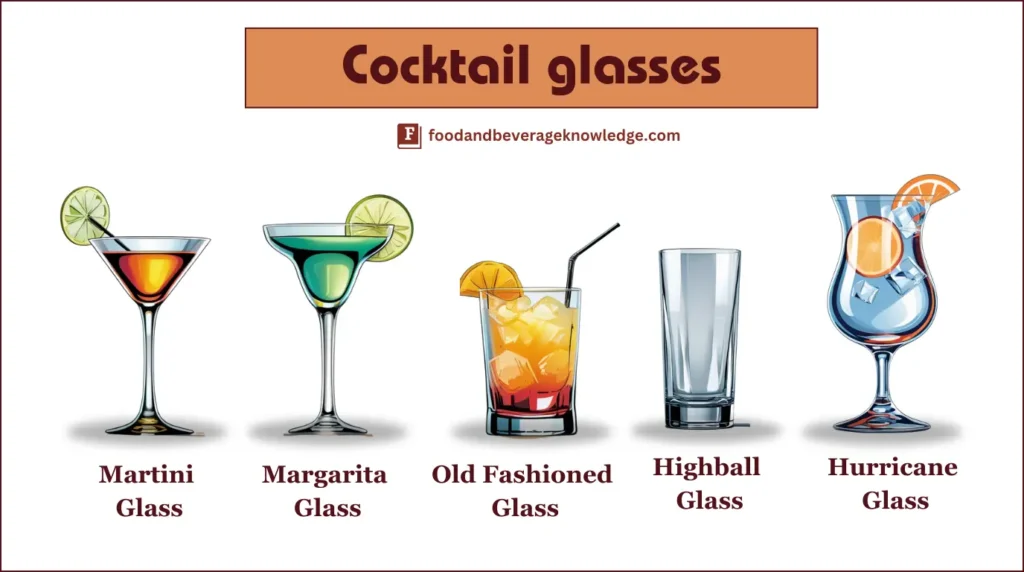
5. Martini Glass
Size: 6–8 oz
The Martini Glass has a wide, conical bowl that allows for maximum exposure of the drink, helping to release aromas. Its sleek design and long stem make it ideal for serving classic cocktails without warming the drink from hand contact. Perfect for martinis, cosmopolitans, and other “straight-up” drinks.
6. Margarita Glass
Size: 10–12 oz
This glass features a broad, curved bowl with a rim that can be salted or sugared, making it the quintessential glass for margaritas. The unique design enhances the presentation of frozen cocktails or those with a salted rim. Commonly used for serving margaritas, daiquiris, and other fruity, frozen cocktails.
7. Old Fashioned Glass (Rocks Glass)
Size: 8–10 oz
A low, sturdy glass with a thick base, the Old Fashioned Glass is ideal for serving cocktails with ice, like whiskey, rum, or a classic Old Fashioned. Its compact, heavy design makes it great for muddling ingredients like fruits or herbs. Used for both spirit-forward cocktails and cocktails served “on the rocks.”
8. Highball Glass
Size: 10–12 oz
Tall and straight with a narrow mouth, the Highball Glass is perfect for cocktails mixed with soda or tonic water. It’s typically used for long drinks, allowing the mix of spirits and mixer to come together smoothly. Commonly used for serving cocktails like Gin and Tonic, Rum and Coke, or Vodka Soda.
9. Hurricane Glass
Size: 12–16 oz
The Hurricane Glass is a tall, curved glass, perfect for tropical cocktails with elaborate garnishes. Its unique shape gives a dramatic presentation, making it a favourite for drinks like Piña Coladas, Mai Tais, or Zombie cocktails. Its wide bowl allows for ice and fruit garnishes, enhancing the visual appeal.
Beer glasses
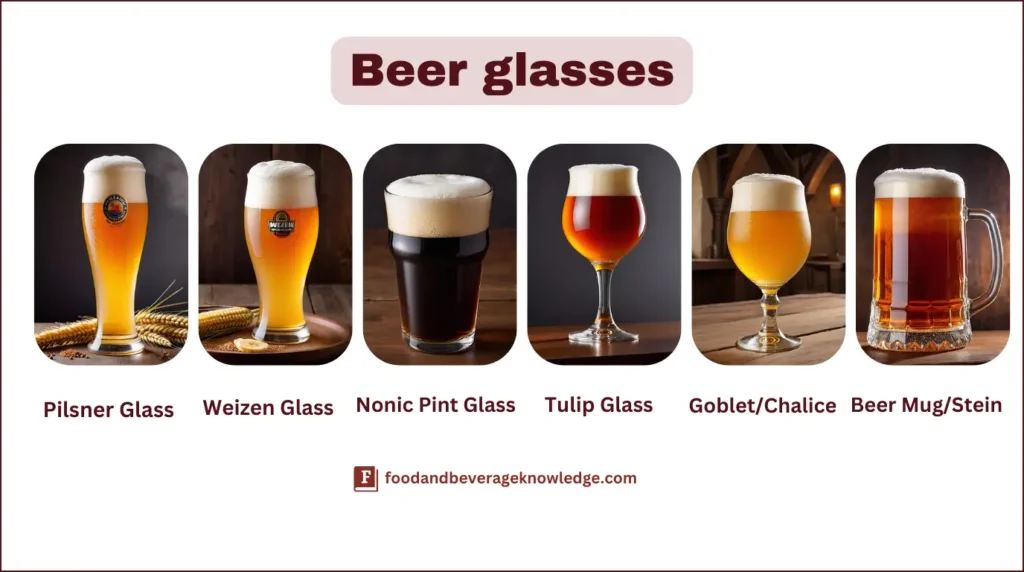
10. Pint Glass
Size: 16–20 oz
The Pint Glass is one of the most commonly used glasses for beer, especially in pubs and casual settings. It has a simple, straight-sided design and can hold a full pint of beer. This glass is versatile and works well for a wide range of beer styles, including lagers, ales, and stouts.
11. Beer Mug
Size: 16–20 oz
The Beer Mug is a sturdy, handle-equipped glass, often made with thick glass to keep the beer colder for longer. It is perfect for serving draft beer, providing a robust and durable option for casual beer drinkers. The handle makes it easy to hold, even when the beer is poured in larger servings.
12. Pilsner Glass
Size: 12–16 oz
The Pilsner Glass has a tall, slender shape designed to showcase the clarity, carbonation, and foam of a pilsner beer. Its narrow body helps keep the beer cold while the glass’s shape allows it to retain carbonation, making it perfect for serving pilsners and lagers. This elegant glass is also commonly used for other light beers.
13. Stein Glass
Size: 16–20 oz
The Stein Glass is a traditional beer mug, often made from ceramic or glass, featuring a handle and a lid. The lid helps maintain the beer’s temperature and keeps insects out. Stein glasses are typically used for serving larger quantities of beer and are especially popular in German beer culture.
Related:
- 15 Different Types of Beer Glasses: Size, Styles, and Why They Matter
- Beer Glasses: The Ultimate Guide to Choosing the Right Glassware
- How Beer is Made: A Detailed Step-by-Step Guide
- The Ultimate Guide to Draft & Draught Beer: Everything You Need to Know
Spirits & Liqueur Glasses
14. Rocks Glass (Old Fashioned Glass)
Size: 8–10 oz
A low, sturdy glass with a heavy base, ideal for serving drinks “on the rocks” (over ice). It provides a broad surface area for the drink, enhancing flavour and aroma. Often used for whiskey, rum, or cocktails like the Old Fashioned.
15. Shot Glass
Size: 1–2 oz
A small, thick-walled glass designed for quick consumption of spirits. Its compact size makes it ideal for serving shots of liquor, often used for party or ceremonial purposes. Used for tequila, whiskey, or other spirits in single servings.
16. Brandy Snifter
Size: 8–12 oz
A rounded glass with a short stem, designed to allow the brandy or cognac to breathe. The wide bowl collects the aromas, which are then concentrated towards the top of the glass. Perfect for sipping brandy, cognac, or other aged spirits.
17. Cordial Glass
Size: 2–3 oz
A small, stemmed glass with a narrow bowl, designed to serve small portions of sweet liqueurs. Its compact size and elegant design make it ideal for after-dinner drinks or dessert wines. Commonly used for sipping liqueurs like Grand Marnier or Amaretto.
Coffee & Dessert Glasses
18. Irish Coffee Glass
Size: 6–8 oz
A heat-resistant glass with a handle, perfect for serving hot beverages like Irish coffee. Its design ensures comfort while holding hot drinks. Often used for coffee drinks with added liquor or cream.
19. Parfait Glass
Size: 8–12 oz
A tall, clear glass designed to showcase layered desserts like parfaits or ice cream. The shape allows the layers to be seen, enhancing the visual appeal of desserts. Ideal for serving layered sweets, parfaits, or mousse
FAQ
Why are different types of glassware used for different drinks?
Different glass shapes influence the aroma, temperature, and overall drinking experience. For example, tall glasses are used for carbonated drinks to retain fizz, while wide-rimmed glasses enhance the aroma of wines and spirits.
What is tempered glassware, and why is it used in restaurants?
Tempered glassware is heat-treated for durability, making it stronger and more resistant to breakage than regular glass. It is widely used in restaurants and bars for safety and longevity.
What are the main types of glassware used in food and beverage service?
The main types of glassware in F&B service include stemmed glassware (e.g., wine glasses, cocktail glasses), tumblers (e.g., highball, lowball glasses), footed glassware (e.g., brandy snifter), and stemless glassware (e.g., beer mugs, juice glasses).
What is the difference between stemmed and stemless glassware?
Stemmed glassware, like wine glasses, has a long stem that helps maintain the temperature of the drink by preventing direct hand contact. Stemless glassware, such as tumblers, is more versatile and casual but may warm the beverage faster.
Conclusion
Glassware plays a crucial role in the food and beverage industry, influencing not only the drink’s presentation but also its taste and overall experience. Selecting the right type of glass enhances the appeal, quality, and perception of a beverage.
Understanding the classification and types of glassware ensures that establishments provide the best drinking experience for their guests, elevating their reputation in the hospitality industry.
Subscribe and join our community of hospitality professionals & students — get insights, tips, and the latest updates delivered straight to your inbox!

